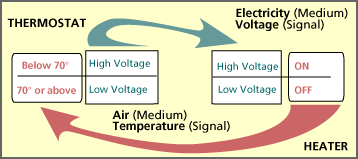
In the heater/thermostat example there are actually three possible messages, each of which is a command:
The signal that travels from the thermostat to the heater is a pattern of electrons that is sent along a wire that connects the two devices. The thermostat can send one of two signals: a high voltage signal, or a low voltage signal.
The heater interprets each of these signals differently. When it receives the high voltage signal, it turns its heating element on. When it recevies the low voltage signal, it turns its heating element off.
The signal that travels from the heater to the thermostat is a pattern of air molecules. When the heater is on, the air warms up and its molecules become more active. When these active molecules bounce off of the thermometer in the thermostat, they are interpreted as indicating a higher temperature. When the heater is off, the air cools down; the molecules become less active and the thermometer records a lower temperature reading.

The picture illustrates the entire process. The heater sends a message to the thermostat indicating the current temperature. This message is coded into "air patterns" by the heater and translated into "thermometer readings" by the thermostat.
The thermostat sends a message to the heater giving it instructions on what to do. This message is coded into electrical signals by the thermostat and is interpreted as one of two actions ("on" or "off") by the heater.
The result is that the two devices "talk" to one another. The heater tells the thermostat how hot or cool it is making the room, and the thermostat tells the heater what to do.